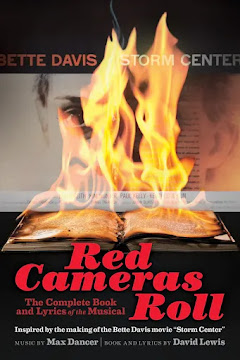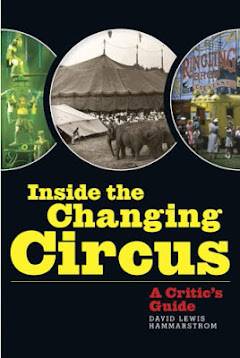Book Review:
The Circus: 1870-1950
Noel Daniel, editor
Dominique Jando, Linda Granfield, and Fred Dahlinger,Jr., contributing writers.
It is so huge and handsome and heavy, so perfectly put together, it will immediately impress you with its sheer grandeur. You will be swept away by the scope and brilliance of its reproductions, many of them rare discoveries that bring back to life the greatness of — yes, mostly Ringling Bros. and Barnum & Bailey Circus under the big top. By that measure alone, there is no other book on the planet I can think of that comes close to this one.
And after a while, you may begin to tire of the arduous journey, as the turning of pages becomes more of an effort and you wonder if you have the will and the muscle to make it on through to the end. You might wonder if too much has been stuffed into the tent. At 670 pages containing some 900 illustrations, The Circus is not a book. This is a 20 pound (I kid you not) museum in your lap. You might get a friend to turn the pages and balance the thing while you, free of a workout, gawk and thrill to the American circus when it was the American circus. The authors are obviously smitten of how we took a one ring darling and turned it into a three-ring spectacular.
Let me make clear the limitations of this review: Yesterday at the San Francisco Public Library where I finally got my hands on a copy, I did not read this book, anywhere near, and I have little desire to. It is not designed to bring out the reader in anybody. I only read bits and pieces, and my impression (I stress impression) is that most of the text is generic. As for the assertion of some, PC-driven, that it offers revisionist history concerning, among other matters, women in the circus, this issue is hardly new, and it has been responsibly covered in other contemporary books.
The Circus directed my attention, page after page, to its captivating photographs. And I felt a sense of euphoria, becoming a circus fan all over again as I wandered through the multitude of epic imagery, against which the earnestly serviceable words that comprise the mini-chapters and captions are like dust in the Roman Coliseum. Many of the black and whites will be familiar to circus fans, I have used some of them in my own books. However, the color reproductions deliver treasures I have never before seen. And that alone makes this bookeum (yes, I just made up a word; it was necessary) a stunning triumph.
For my personal taste (call me biased), Miles White and the man who hired and charmed the best work out of him, John Ringling North, are the stars. And why there are no photos of them, or of any of the other movers and shakers who created these spangled holidays, is a puzzlement. How to count the delights? Photos of performers costumed for one production number after another —parades I never saw — left me left me limp with joy. White’s stupendous creativity is simply unmatchable. Other backyard scenes in color mesmerize. Ballet of the Elephants dancers, all in pink, exiting the big top, whose sidewalls that year were red, with air conditioning wagons nearby. Performers between shows relaxing under the guy lines in lawn chairs along a row of stairwells leading to the private dressing rooms at the ends of the seat wagons.
You are there next to lovely Pinito Del Oro, there next to a young Francis Brunn. There next to a couple of black canvas guys checking out the bale ring around a center pole, only a few feet off the ground. You can almost feel the show going up. There's Lou Jacobs with his Hindenburg-sized cigar, and a young shirtless, anatomically perfect Pete Cristiani, fit for GQ Magazine. A gigantic foldout reproduces a Ringling Bros. 1898 litho featuring a "ladies orchestral symphony" in the center of a menagerie!
And then you may reach a point of numbing overkill. This editor simply could not stop. This Noel Daniel has produced a monster, compared to which, the Parkinson-Fox tome The Circus in America seems petite. There are visual redundancies that border on filler. Certain types of acts or certain artists are over represented. There is no clear narrative at work here, the chapters vaguely delineated one from the other. For example, two different chapters both focus on aerial and/or daredevil acts.
The title? A clear tip-off that Daniel has little interest in a book with a theme and a direction. Really, what is this tome about other than about showing off its massive acquisition of photography and poster art? The text? I wonder, will anybody read it? The essays are far from in-depth (Granfield might have told us why and how one ring became three), the photo captions not much more than functional, and even they sometimes lack specifics. Which is a surprise given the trio of touted expert "scholars" who worked together on this massive project. I guess even a committee can make mistakes.
The book is not error free. I paused now and then to read captions for photos that caught my fancy, I stumbled upon a few errors. Takeo Usui “wire dancing”? He worked an inclined wire, executing forward and backward slides. We learn on one page that the title "The Greatest Show on Earth" was first used by P.T. Barnum in 1872; on another page, in 1873. I thought the slogan emerged a few years later, but I could be wrong. A 1947 photo of an elephant and a woman, the woman identified as a “fan,” looked to me like Betty Hutton, which would place the photo closer to 1951. A 1952 aerial ballet photo mentions 60 women aloft; most will tell you that North never employed more than 48.
Does it matter? Evidently, not to Daniel. If text mattered, why does some of it appear on color backgrounds? And why in three languages? The cumbersome and bulky layout taxes one's patience and resolve. Indeed, trying to read this glorious hodgepodge feels like trying to read a Times Square theatre flyer through a blinding flash of neon lights. The title is carelessly misleading. 1950 really should have been 1956, for that is when the great American circus came to an end — in Pittsburgh. And why 1870? The coverage extends back to Circus Maximus days and before, perhaps back to the Garden of Eden, I did not get that far into the chapter.
But, oh, the photos! Simply to die for. Some of these images are revelations. A dancer ready to go on in Ringling’s 1956 elephant bash, “Ringling Rock N' Roll,” reveals the brilliance of a Vertes costume design, and the savvy of North in hiring him. Sadly, it was the wrong season. The same season delivered perhaps the shabbiest spec ever, a parade entitled "Say it with Flowers" that ended up looking more like "Say it with Cement." Photos of that misfire would have helped bring this book to a more dramatic and historically accurate conclusion. But, in the end, we are back where we began, back gawking at thrill acts under mammoth tents attended by thousands of enthralled spectators. Back in a wonderland of hoopla, courage and beauty that bursts vividly through in these magnificent illustrations. Words not needed.
Subscribe to:
Post Comments (Atom)






















2 comments:
Show Biz,
Great review/commentary once again. If you read this statement, would it sound like someone smitten with a three-ring spectacular:
"Keep in mind that in Europe, audiences actually watched the acts (in a one-ring circus, it's difficult to do otherwise) and were pretty savvy"
Wade Burck
Maybe I was so enthralled with these fabulous photos, that my own favorites gave me a distorted view. Maybe one day I will go back to the bookeum over there in SF, and discover a different focus. The statement you quote is likely to get lost in the monster parade that comes marching through this epic laptop museum.
Post a Comment